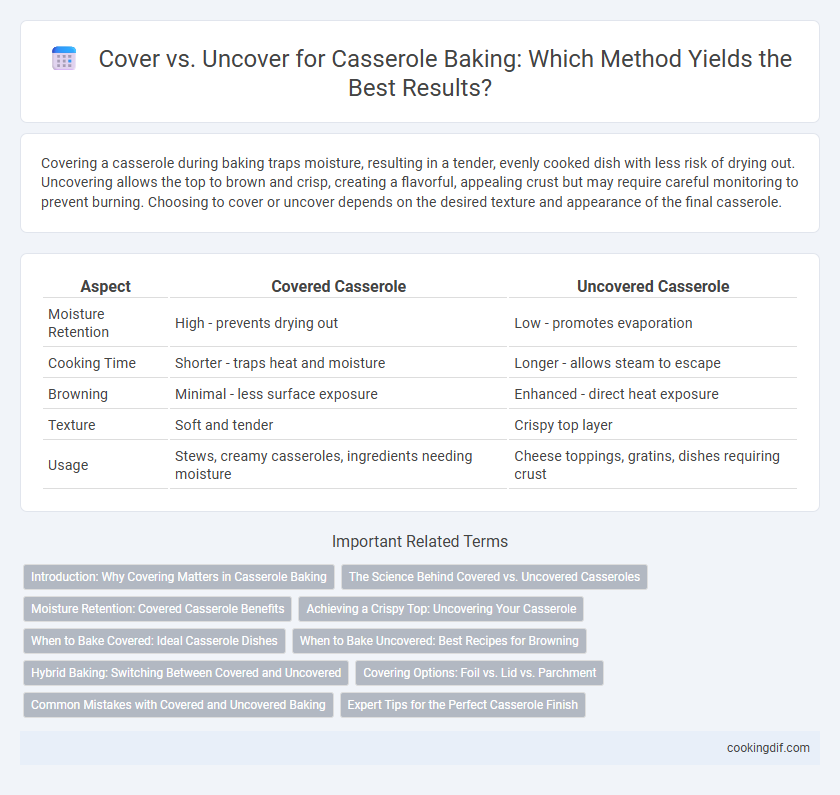Covering a casserole during baking traps moisture, resulting in a tender, evenly cooked dish with less risk of drying out. Uncovering allows the top to brown and crisp, creating a flavorful, appealing crust but may require careful monitoring to prevent burning. Choosing to cover or uncover depends on the desired texture and appearance of the final casserole.
Table of Comparison
| Aspect | Covered Casserole | Uncovered Casserole |
|---|---|---|
| Moisture Retention | High - prevents drying out | Low - promotes evaporation |
| Cooking Time | Shorter - traps heat and moisture | Longer - allows steam to escape |
| Browning | Minimal - less surface exposure | Enhanced - direct heat exposure |
| Texture | Soft and tender | Crispy top layer |
| Usage | Stews, creamy casseroles, ingredients needing moisture | Cheese toppings, gratins, dishes requiring crust |
Introduction: Why Covering Matters in Casserole Baking
Covering a casserole during baking helps retain moisture, preventing the dish from drying out and ensuring tender, evenly cooked ingredients. It also traps heat, promoting thorough cooking while preserving flavors and textures. Uncovered baking allows for browning and crisping of the top layer, often enhancing presentation and adding a desirable texture contrast.
The Science Behind Covered vs. Uncovered Casseroles
Covering a casserole during baking traps steam and moisture, promoting even cooking and preventing the dish from drying out. Uncovered casseroles encourage evaporation, resulting in a thicker, browned, and crispier top layer due to Maillard reactions and caramelization. The choice between covered and uncovered baking influences texture, moisture retention, and flavor development by controlling heat and moisture exchange within the oven.
Moisture Retention: Covered Casserole Benefits
Covering a casserole during baking significantly improves moisture retention, preventing the dish from drying out and ensuring a tender, juicy texture. The lid or foil traps steam inside, which keeps ingredients like vegetables and meats succulent and flavors well-infused. Uncovered casseroles tend to develop a crispy top but risk evaporating essential moisture, potentially leading to a drier result.
Achieving a Crispy Top: Uncovering Your Casserole
Uncovering your casserole during the final 10-15 minutes of baking promotes a crispy, golden top by allowing moisture to evaporate and heat to directly brown the surface. Covering the casserole traps steam, which softens the ingredients and prevents the formation of a crunchy crust. For optimal texture contrast, bake covered to cook thoroughly, then uncover to achieve that desirable crisp finish.
When to Bake Covered: Ideal Casserole Dishes
Baking casseroles covered is ideal for dishes that require moisture retention, such as creamy or saucy recipes like lasagna, chicken and rice, or green bean casserole. Covering prevents the top from drying out and allows even cooking by trapping steam inside. It also helps tenderize ingredients, making it perfect for casseroles with delicate proteins or long baking times.
When to Bake Uncovered: Best Recipes for Browning
Baking casseroles uncovered is ideal for recipes that benefit from a browned, crispy top layer, such as macaroni and cheese or gratins. Exposing the dish to direct oven heat encourages Maillard reactions, enhancing flavor and texture by creating a golden crust. Uncovered baking is best in the final stages of cooking to avoid drying out while achieving an appealing, caramelized finish.
Hybrid Baking: Switching Between Covered and Uncovered
Hybrid baking for casseroles enhances texture by starting the dish covered to retain moisture and ensure even cooking, then finishing uncovered to allow the top to brown and develop a crispy crust. This method balances moisture retention during the initial stages with attractive, flavorful caramelization at the end. Switching between covered and uncovered baking optimizes both tenderness and visual appeal in casseroles.
Covering Options: Foil vs. Lid vs. Parchment
Choosing the right cover for casserole baking significantly impacts moisture retention and browning. Aluminum foil seals in steam effectively, preventing drying, while a lid provides an airtight fit that maintains consistent heat and moisture. Parchment paper allows slight venting, helping achieve a crisp top without excessive moisture buildup, ideal for recipes requiring a balance between steaming and browning.
Common Mistakes with Covered and Uncovered Baking
Covering a casserole traps moisture, which can cause a soggy texture, while leaving it uncovered often leads to over-browning or dryness if not monitored carefully. Common mistakes include failing to adjust cooking times when changing from covered to uncovered baking, resulting in undercooked interiors or burnt tops. Using foil or lids inconsistently without understanding the recipe's moisture content leads to uneven cooking and less desirable texture.
Expert Tips for the Perfect Casserole Finish
Covering a casserole during baking helps retain moisture and ensures even cooking, preventing the dish from drying out or burning. Uncovered baking allows the top to brown and develop a crispy, golden crust that enhances texture and flavor. Experts recommend starting covered to cook through, then uncovering in the last 10-15 minutes to achieve a perfectly browned and appealing finish.
Cover vs Uncover for casserole baking Infographic

 cookingdif.com
cookingdif.com